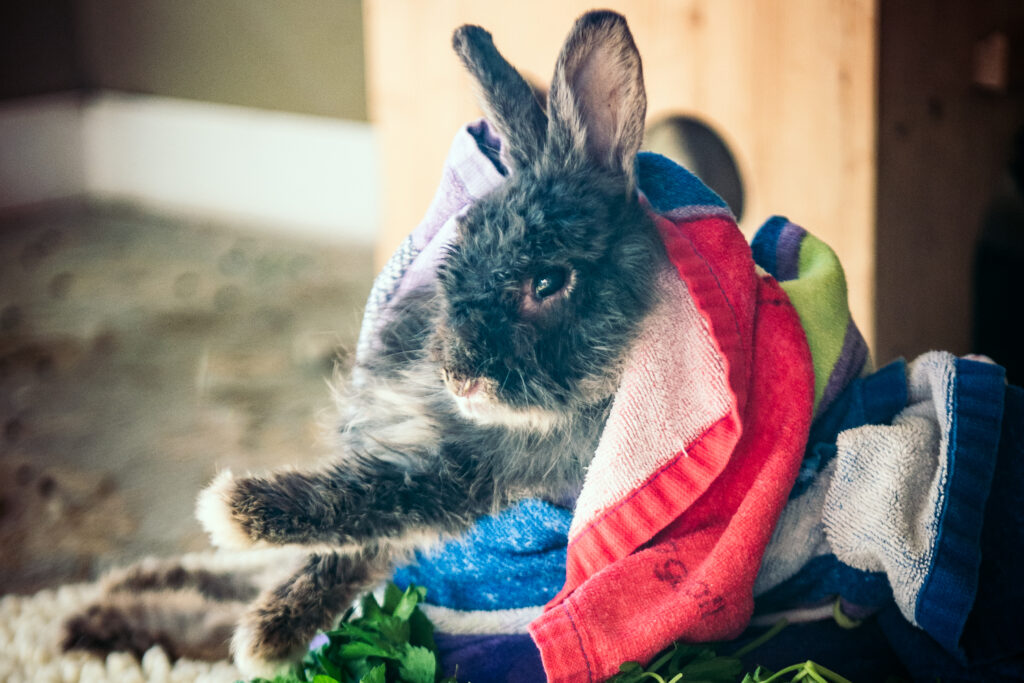When rabbits lose their mobility, upright posture, or ability to reach and groom their extremities, they will need assistance with hygiene and their other daily tasks. Animals seem to have much less difficulty adjusting to loss of mobility than their humans do. Rabbits with crippling disease may stabilize and live comfortably for a prolonged period of time.
Millions of humans are on lifelong medication, for everything from allergies to heart disease, without question as to quality of life. We don’t destroy humans who are missing a limb or have a physical impairment. So this is not the solution for an animal who is not in pain. My online article addresses several of these issues.”
Habitats For Disabilities
Prepare a habitat for your impaired bunny that emphasizes safety, comfort, entertainment, and interaction. Pad the environment with fake fleece or pet bedding to prevent pressure sores, with wicking towels underneath and pillows of rolled rugs along the perimeter.
Elevated solutions. Elevated living spaces provide convenience for the caregiver. By elevated I mean any housing arrangement that brings bunny up to your waist level. This could be a padded desktop, table, or any raised platform, preferably close to a window. Immobile rabbits appear to be entertained by watching birds and squirrels and even people doing yard work.
A low fence is suffcient for bunnies who can’t hop. You want it high enough to be safe and low enough that you have easy access. Floor setup. Bunnies with limited mobility can also use a comfortably furnished pen on the #oor. Provide pillows of rolled-up towels or rugs to lean against. A #oor habitat or pen is an amicable arrangement for bonded rabbits who have differing abilities. Leave the door open so that the able-bodied friends can go in and out.
Cage setup. Many immobile rabbits are perfectly happy in a cage with companions, Fosterer Donna Jensen keeps hers in groups, three–four to a cage in a triple-decker condo. “Although space is limited,” she says, “they don’t seem to mind, and they naturally bunch themselves together.” Furnishings. All setups include washable rugs, flat food bowl, water bottle, padded supports, toys, companion(s), litterbox (maybe), and a nice view. If your disabled bunny spends supervised time outdoors, drape netting or window screening over the pen to keep out again! flies and mosquitoes.
Feeding
Eating diffculties for some disabled rabbits are overcome by placing food within easy reach. #ey can eat the same hay, veggies, and pellets that are good for ambulatory rabbits. Frail, anorectic bunnies may need supplemental hand feedings of special formulas prescribed by your vet. Set out less perishable produce and hay for while you are away, and then give supplemental feedings when you are home. Set him next to his water bottle two–three times a day.
Skin Care
Urine scald is one of the more common problems encountered in rabbits who are unable to “posture” and thus project urine away from their bodies. Constantly soaked fur on any part of the body can result in painfully inflamed skin underneath. Shaving all at-risk areas allows you to monitor and treat the skin. Preventing/treating scald begins in choosing a bathing technique that establishes a healthy epidermal barrier that prevents pathogens from entering the body. To do this, the skin must be kept slightly acidic.
When bathing bunny’s hindquarters, always use a pH-balanced soap or cleanser. After thorough drying, apply a moisture barrier⁄skin sealant to preserve lipids and keep urine or feces from penetrating skin cells. Moisture-barrier ointments used for bunnies are petrolatum or lanolin (no zinc). An all-in-one option is to douse the soiled area with a no-rinse, pH-balanced cleanser that contains lanolin. Human cleansers are safe on areas not licked by bunnies. Blot the cleansed area with soft tissue.
As damaged skin is repaired, a certain amount of sloughing is normal. thee top layer of dead skin cells will slough off as new cells are building from underneath. the gentlest way to remove a sloughing layer is to massage it gently with the protective ointment to remove only the loose dead material.
When To Use Diapers
The main reason to diaper a bunny is to wick away moisture from tender flesh. Changing them three times a day is usually adequate, using newborn size diapers. If your veterinarian recommends expressing your rabbit’s bladder, you will be given a demonstration. There are varying techniques.
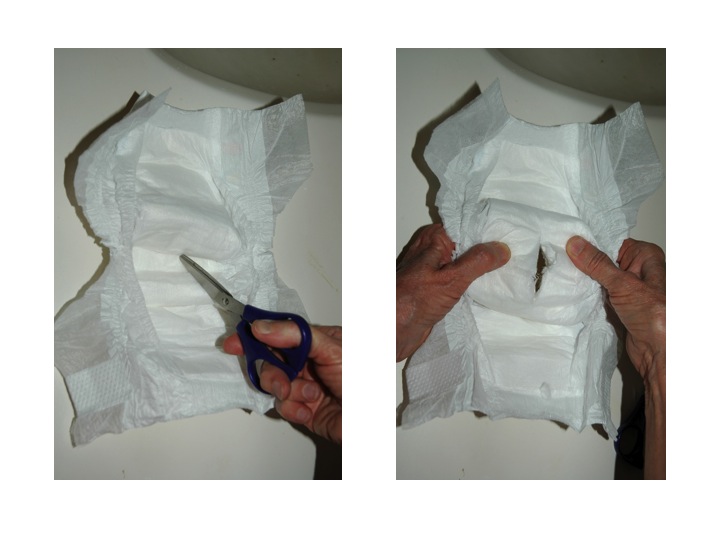
Diapers can be used frontwards or backward, depending on where you want them fastened.
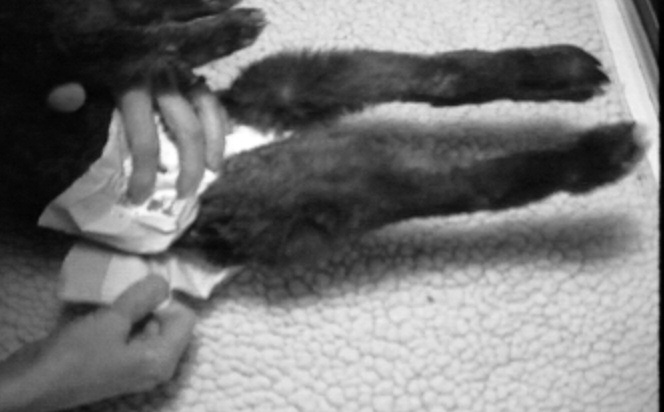
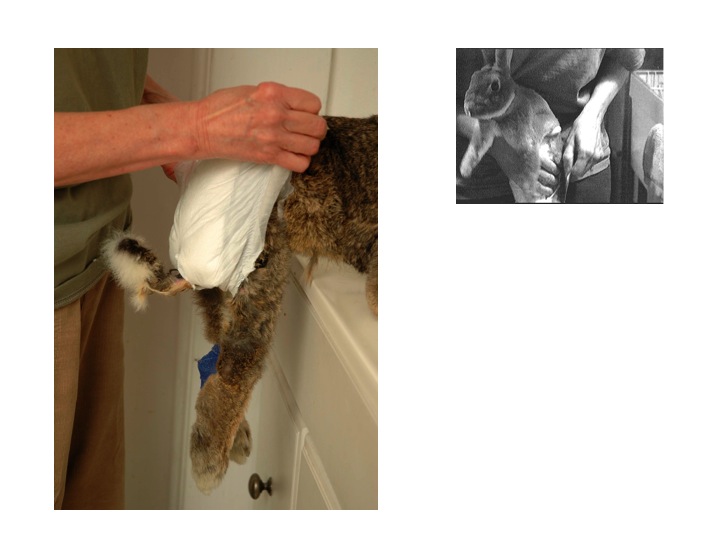
The photos illustrate two front-wrapping methods that I use. Other caregivers do equally well fastening the diaper at the back. Successful fitting, which keeps the diaper on, is done by notching the leg edges at the front. If you are turning the diaper backwards, make your notches at the back (which is now the front).
Do the appropriate cleaning each time you change the diaper. But first check for those vitamin-packed cecotropes and give them to bunny.
Activities
If your bunny has lost any of his senses, provide activity for the others. If he can’t see, turn on soft music. Provide toys that fit with bunny’s abilities: some to toss, some to cuddle, some to chew, and some with wheels for mobility. Other a variety of veggie treats and repeat the favorites. A compromised lifestyle doesn’t have to mean misery.
Interaction with companions is the best therapy for an infirmed rabbit. Disabled rabbits are wonderful at taking care of each other. Most of the time, they accept partners readily. When I put them together, I use the simultaneous-petting technique (page &’). Donna Jensen adds Rescue Remedy (flower essence spray) for its calming effect. There are many great tips available for improving the quality of care for special-needs bunnies.
Amy Spintman brought many of these tips to us in her seminar presentation at the Rabbit Center.( Amy’s website provides ongoing resources for caregivers, ) as well as a link to a support group for disabled-rabbit care.*
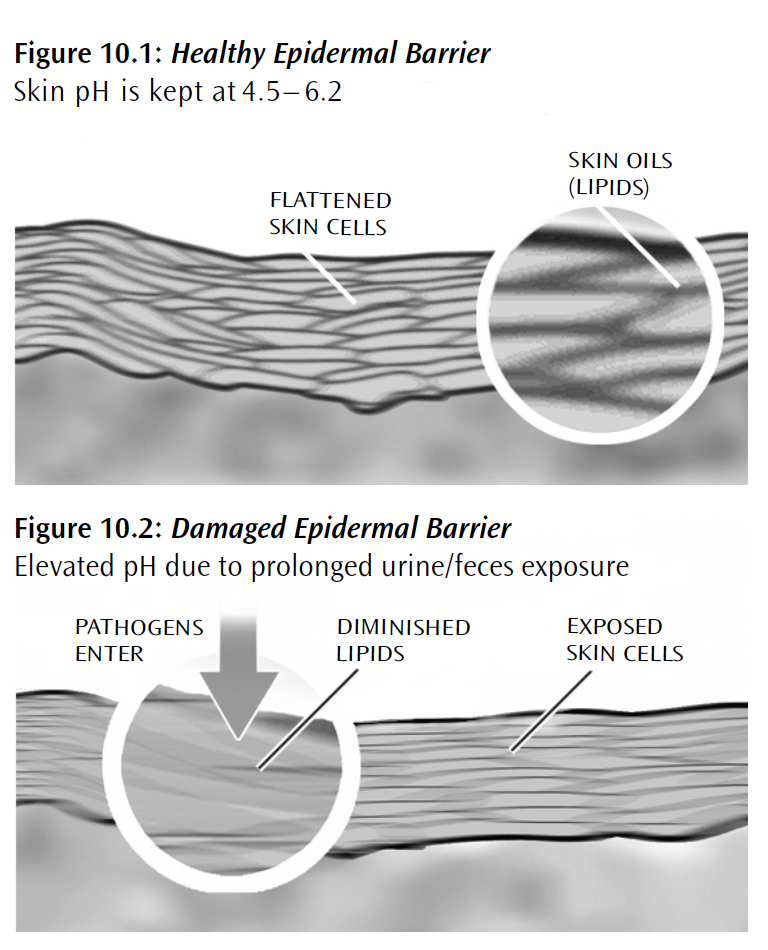
Healthy skin (Figure 10.1): The outer layer of skin called the epidermal barrier consists of flattened skin cells (corneocytes) and skin oils (lipids). This layer is covered by a thin, slightly acidic, protective film known as the acid mantle (pH: 4.5– 6.2).
Damaged skin barrier (Figure 10.2): Acid mantle is disrupted by repeated cleanings, that raise pH. Skin pH is further raised by exposure to alkaline urine or fecal matter, which activate enzymes that damage the barrier and allow pathogens to penetrate skin cells.
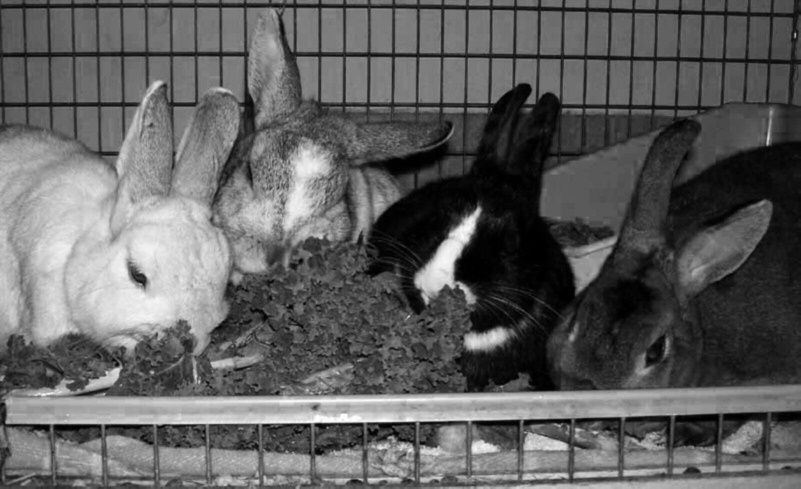
Cozy cage living (upper left) is a good solution for disabled rabbits who thrive on intimacy and support each other.
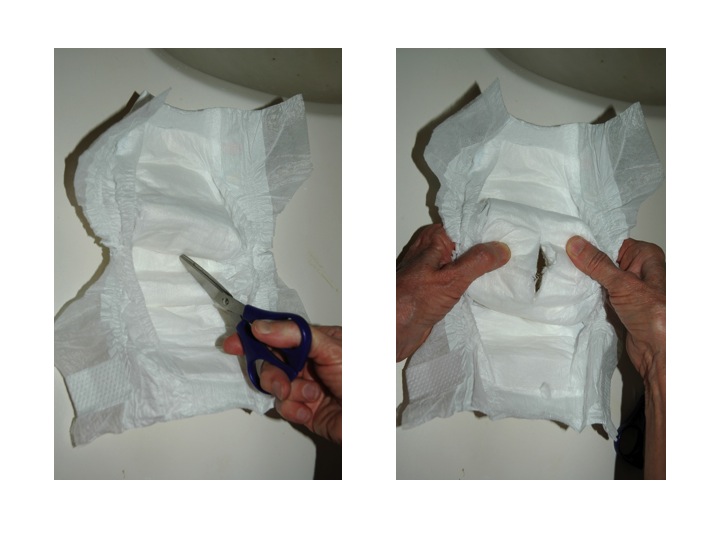
Cut to fit: (above) Punch a tail hole (optional) squarely in the middle of the diaper. Notch deeply into the leg edges at the front, making it curve around the legs.
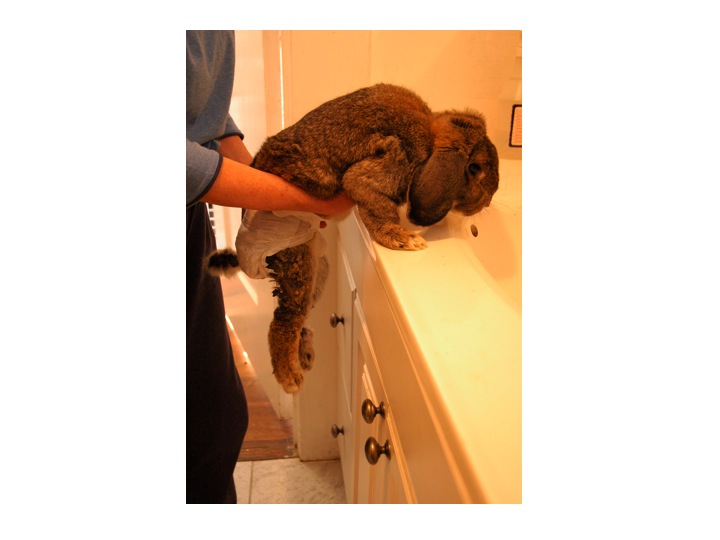
Paws on counter. Bunny dangles while diaper is being fastened.
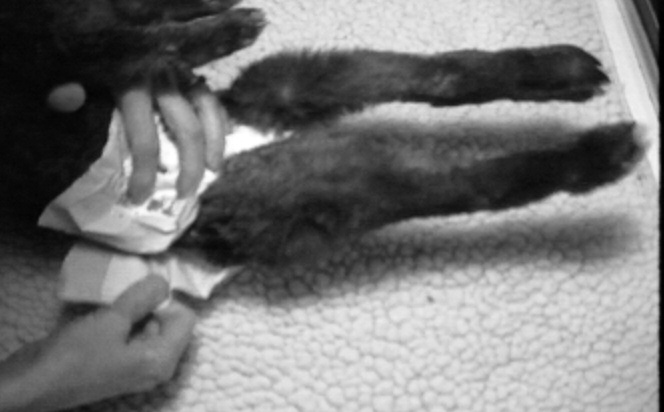
Hips on counter. Bunny reclines on back for diaper fastening.
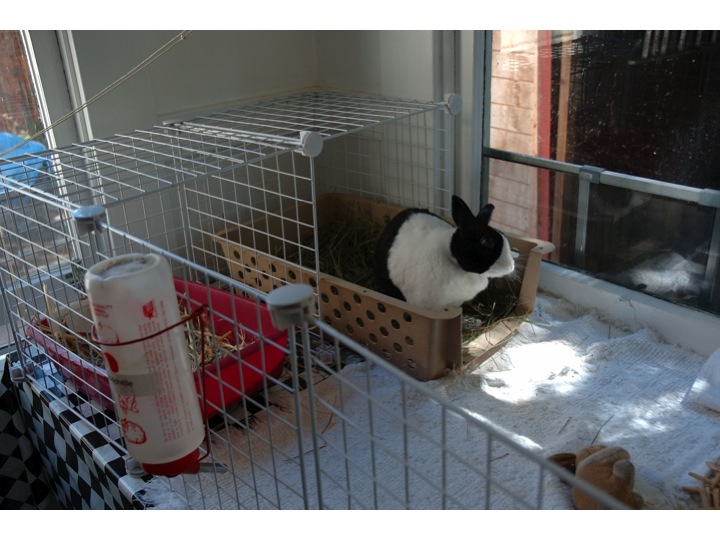
Platform living on a table top suits Rudy (above) who gets comfortable on his pillow in the window sill.
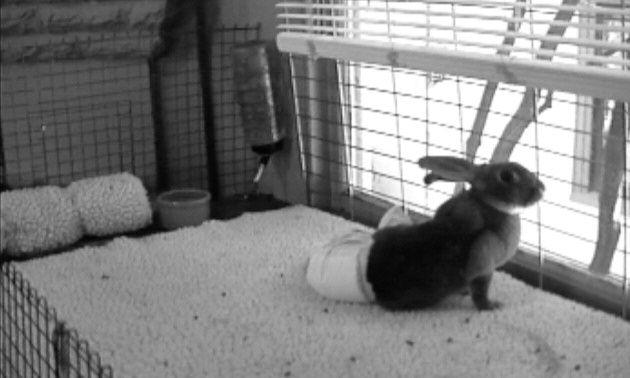
A padded desktop by a window (below) gives Dexter an enjoyable view.
A floor penworks for Dylan, who can navigate with one stiff leg and get into a litterbox. “
Amy Spintman, “Caring for Disabled Rabbits.” Master Seminar
Online Support Groups
Facebook Disabled Rabbits Group
Further Reading
Disabled Rabbit Resources (CatsandRabbitsandMore.com)
©Copyright Marinell Harriman. All Rights Reserved. Republished with the permission of the author.
